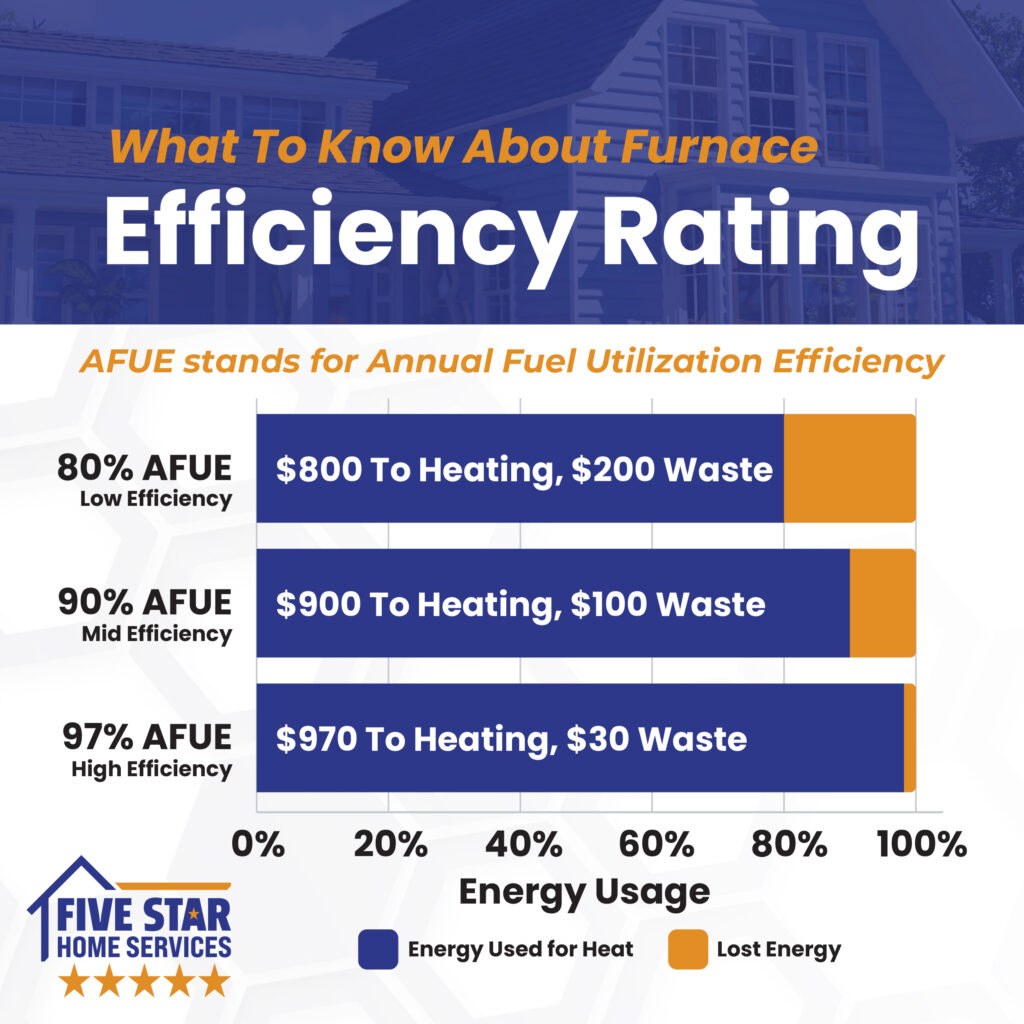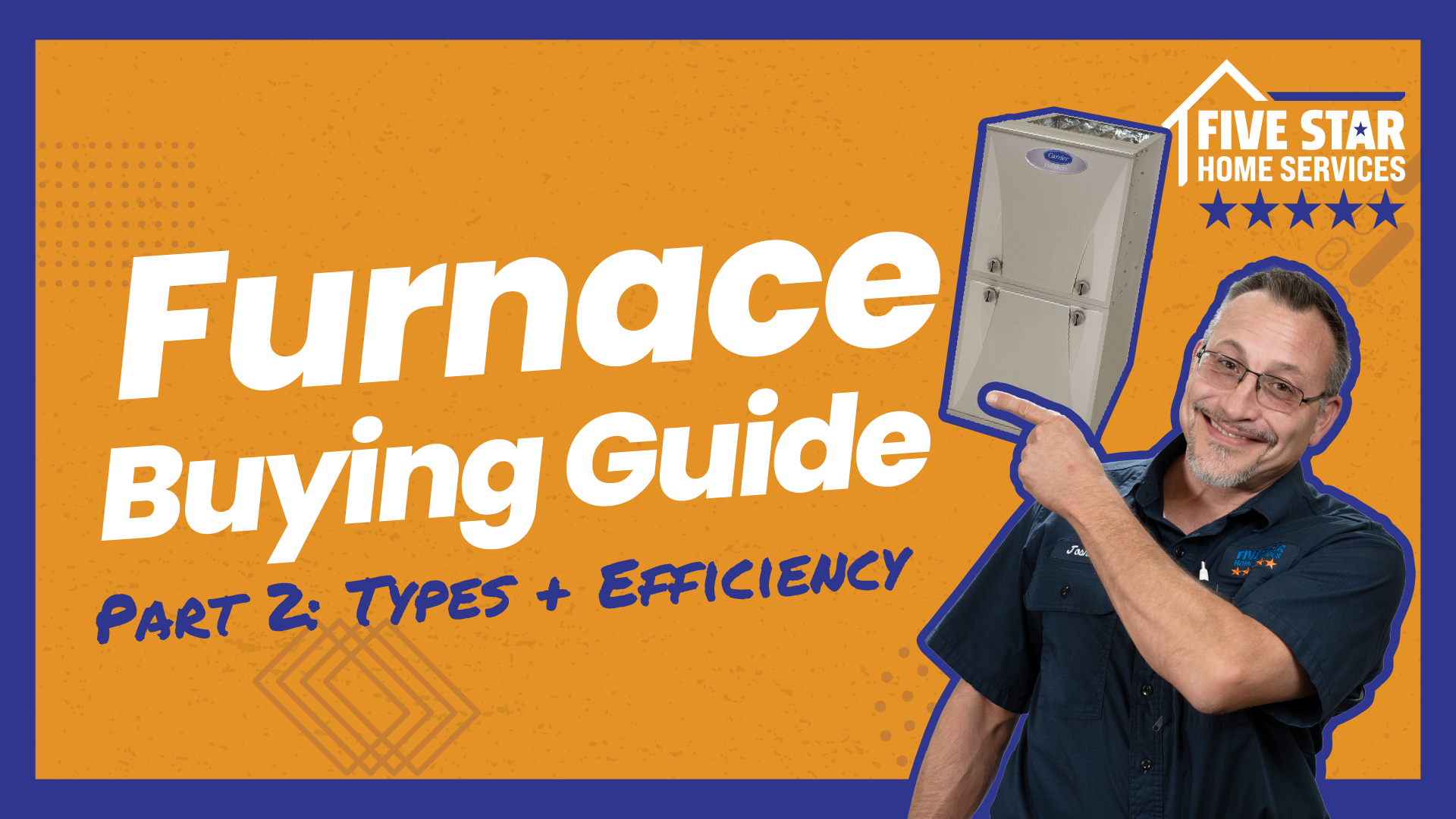Welcome back to the second part of our five-part furnace buying guide. Now that we’ve discussed what you need to know when it’s time to replace your heating system, we will explore the different types of furnaces available and their efficiency ratings.

As your local heating experts in Columbus, Dayton, Cincinnati, and surrounding areas, we at Five Star Home Services look to give you an overview of the most common furnace types, explain their energy efficiency ratings, and offer tips on choosing the right furnace for your home. Let’s explore the different types of furnaces first, including fuel sources and modes of operation.
Overview of Common Furnace Types by Fuel Source
Gas Furnaces
Gas furnaces are a popular option among homeowners because of their high efficiency and lower operating costs. They use natural gas or Propane to generate heat, which is then distributed throughout the home via the ductwork.
Benefits of Gas Furnaces:
- Varying efficiency capabilities
- Faster heating throughout the home
- Lower fuel costs compared to oil or electricity
- Consistent heating and temperature control, especially in colder climates
- Inexpensive to maintain and can last twice as long as electric heat pumps
Drawbacks of Gas Furnaces:
- Requires a natural gas or propane supply
- Potentially higher upfront installation costs
Electric Furnaces
Electric furnaces are another popular option for some Ohio homeowners, especially in Ohio, where they are known for being efficient, reliable, and easy to install. Using an electric heating element to warm the air, electric furnaces blow heat into your home. They are usually more affordable to install but can be more expensive due to higher electricity costs.
Benefits of Electric Furnaces:
- Easy maintenance
- Lower installation cost
- Safer as there’s no combustion process
- Newer models can improve indoor comfort
Drawbacks of Electric Furnaces:
- Higher operational costs
- Slower to heat a home compared to gas furnaces
- They emit dry heat, which can dry out the air in the winter
🔥 Featured Blog: Gas Furnaces vs. Electric Furnaces — Which Type is Right for You? ➡️
Understanding the Different Types of Furnaces by Modes of Operation
If you’re in the furnace buying process, choosing the right system can be daunting—especially when faced with various options. Whether you’re upgrading your current system or installing a new one, it is essential to understand the different modes of operation, including single-stage, two-stage, and variable-speed furnaces.
Single Stage Furnaces
What is a Single Stage Furnace?
Single-stage furnaces operate on a simple on/off mechanism. When the thermostat detects that the indoor temperature is below the desired set point, the furnace kicks on at full capacity to raise the temperature. Once that desired temperature is achieved, the unit shuts off completely upon completing its cycle.
Benefits of Single-Stage Furnaces
- Simplicity: With fewer components, single-stage furnaces are easier to operate and maintain.
- They’re Cost-Effective: Usually, single stage furnaces are the most affordable option, both in terms of initial cost and overall maintenance.
Drawbacks of Single-Stage Furnaces
- Efficiency: Since the furnace only operates at full capacity, it can lead to uneven heating and higher energy consumption.
- Comfort: The on/off cycle can create noticeable temperature swings, resulting in uneven heating where some rooms feel too hot or too cold.
- More Wear and Tear: Single-stage furnaces develop more wear and tear over time.
- Noise: Single-stage furnaces can make more noise when they turn on or off, and sometimes during regular operation.
Two Stage Furnaces
What is a Two-Stage Furnace?
Two stage furnaces offer homeowners more flexibility than a single stage unit. These models operate at two different levels of heating production — high and low. Typically, the furnace runs on the lower setting to maintain a consistent temperature. It switches over to the higher setting only when necessary.
Benefits of Two-Stage Furnaces
- Equipment Longevity: Because two-stage furnaces don’t work as hard, they often last longer than other types of furnaces which saves you money in many ways.
- Enhanced Efficiency: By operating at a lower setting much of the time, two stage furnaces consume less energy.
- Enhanced Comfort: These furnaces provide more even heating while reducing temperature fluctuations. Their lower setting allows the furnace to run longer, increasing air circulation.
- Less Noise: Running on a lower setting also means the furnace is generally quieter.
Drawbacks of Two-Stage Furnaces
- Higher Initial Cost: Although they offer better efficiency, two-stage furnaces are more expensive upfront to install.
Variable-Speed Furnaces
What is a Variable-Speed Furnace?
Among the three modes, variable-speed or modulating furnaces stand out for their performance. These furnaces take comfort and efficiency to the next level. Unlike single- and two-stage furnaces, variable-speed systems can adjust the blower motor speed to control airflow precisely and modulate the gas pressure to maintain a constant and consistent temperature.
Benefits of Variable Speed Furnaces
- Maximum Energy Efficiency: These home heating systems optimize energy usage by adjusting speed and output based on real-time needs.
- Superior Indoor Comfort: Variable-speed furnaces provide the most consistent temperature control, drastically reducing hot and cold spots to ensure even heating throughout the home.
- Improved Indoor Air Quality: The continuous operation at variable speeds helps improve indoor air quality by constantly filtering the air.
- Quieter Operation: Variable-speed motors ramp up to full speed gradually rather than suddenly, whereas traditional furnaces’ sudden starts are usually noisy.
- Lower Maintenance Costs: Surprisingly, variable-speed furnaces are cheaper to maintain than traditional furnaces.
Drawbacks of Variable Speed Furnaces
- Higher Cost Upfront: These are the most expensive type of furnace to purchase and install.
- Professional Installation a Must: Variable-speed furnaces may also cost more to install. Because of their complexity, it is important to choose a reputable contractor to set up the furnace controls.
🔥 Featured Blog: A Guide to High-Efficiency Furnaces ➡️
Understanding Energy Efficiency Ratings
AFUE (Annual Fuel Utilization Efficiency)
In addition to fuel types and modes of operation, another important factor homeowners should consider when purchasing a new heating system is the equipment’s energy efficiency ratings. A furnace’s AFUE rating measures how efficiently the system converts fuel into heat over one year. This number is expressed as a percentage. Because of this, a higher AFUE rating means more efficient energy use.
🔥 Featured Blog: What is AFUE? ➡️
Example:
- An AFUE rating of 90% means that 90% of the energy in the fuel becomes heat, and the remaining 10% is lost through the Exhaust.
Why Efficiency Matters
- Comfort: Newer efficient heating systems can provide more consistent heating.
- Cost Savings: Higher efficiency means lower utility bills.
- Environmental Impact: Efficient furnaces use less fuel, reducing your carbon footprint.
- Longer Lifespan: Newer more efficient models last longer than outdated technology.
Tips on Choosing the Right Furnace
Evaluate Your Needs
- Budget: Look at the upfront cost of the furnace, in addition to installation costs, durability, and energy efficiency.
- Availability: Choose a furnace that uses the most readily available and affordable fuel in your area.
- Your Current Set Up: Factor in what your home is already set up for. The less evasive the need to make major changes to the home, such as installing gas lines or air ducts, the less expensive the installation.
- Size is Essential: Remember, a furnace that’s too small might not heat your home properly. Additionally, one that’s too large can increase your energy costs and put strain on the system that shortens its lifespan and causes problems. The size of your home, its climate, insulation, and the number of occupants can all help you determine the right size. We’ll explore sizing more in part three of this series.
Consider Efficiency
- Higher AFUE Ratings: Look for furnaces with higher AFUE ratings for better efficiency and lower operating costs.
Additional Factors to Consider
- Variable Speed Blowers: These offer better air circulation and energy savings.
- Smart Thermostats: These can further enhance the efficiency of your furnace by optimizing heating schedules.
- Your Heating Needs: Think about any specific heating needs or preferences you may have.
- Equipment Warranties: A furnace’s warranty coverage can protect you if you have issues with your new system in the future. Follow the next step below to keep that warranty active.
- Keep Up on Maintenance: Regular maintenance can help your furnace perform better, last longer, and reduce energy and repair costs. An ounce of prevention is worth a pound of cure.
📁 Download our 2024 Furnace Buying Guide ➡️
Need More Help? Just Call Five Star Today!
Understanding the different types of furnaces and their efficiency ratings will help prospective homeowners like yourself make an informed decision that suits your needs and budget. Whatever you choose, evaluating your specific requirements will ensure you choose the best furnace for your home.
If you’re ready to upgrade your heating system or have more questions, please call your friends at Five Star Home Services today to find the perfect furnace for your home and enjoy a warm, comfortable winter in Columbus, Dayton, or Cincinnati!

